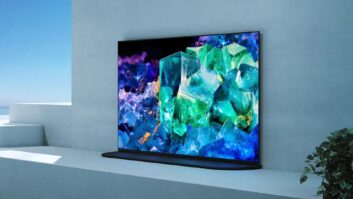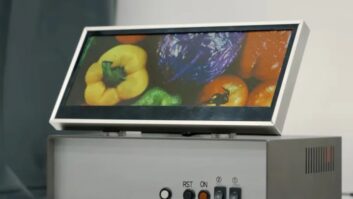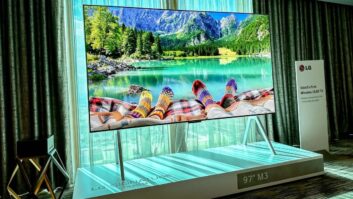Texas Instruments travels to CES this week to announce that its Digital Light Processing (DLP) projection TV display technology is poised to reach the next major milestone in consumer acceptance.
At its booth, the company will showcase products from many of the 30 projection TV manufacturers that have licensed its Digital Micromirror Devices (DMD) for next-generation, fixed-pixel HDTV and EDTV DLP displays. Most of the projectors produced to date have included 4:3 (600×848) chips, primarily used for business applications and for some home theater models with widescreen format conversion technology.
But the company’s more recent breakthrough came two years ago in the release of its HD-1 DMD chip featuring increased pixel resolution (1280×720) and a widescreen aspect ratio for full HDTV monitor displays. The chip first appeared in a crop of widescreen rear projection monitors from Mitsubishi, Panasonic and Hitachi, and last year surfaced in a number of front projectors from Sharp, Marantz and SIM2 Seleco. The field is expected to swell considerably with announcements at the show.
More significantly, TI executives said their engineers have been hard at work on next-generation chip designs that will appreciably reduce the build-of-materials costs for DLP TVs, and consequently reduce prices to more affordable levels.
The current threshold for a home entertainment DLP front projector is found in the PLUS Corp.’s Piano model, which carries a $2,999 suggested retail and uses an 848×600 4:3 chip for Enhanced Definition TV resolution levels. The entry price for a front projector using the HD-1 chip comes in Sharp’s XV-Z9000U model listed at $10,995. Panasonic currently offers the lowest price for an HD-1 based rear projector in the PT-52DL10 at a $10,995 suggested retail.
Starting later this year, however, TI said the market picture should change dramatically with a new group of tabletop DLP rear projection monitors that are expected to see retail prices closer to $3,000. Such pricing has already been announced in plans for Europe from such companies as Vestel (based in Turkey) and Loewe (based in Germany). Both companies also recently established U.S. sales offices.
John Reder, TI’s DLP home entertainment tabletop business unit manager, said his company’s long-range goal is to compete head-to-head on price with CRT based video projectors and ultimately to overtake that business. It’s expected that a third generation chip (code named Mustang) will allow CRT-level prices sometime in 2004.
Texas Instruments acknowledges it still has some obstacles to clear before attaining its goal. The company said DLP now beats or competes with CRT designs for image sharpness, longevity and overall brightness. But it is still trailing in contrast ratio (although significant gains have been made here in new designs) and most significantly in volume production and pricing.
The company believes the benefits DLP will bring, such as sharper pictures for video as well as text and graphics displays, brighter pictures and greatly reduced cabinet designs, will drive the market if prices are brought down to about 1.5 times those of similarly featured CRT-based products.
“What we have to do in the next generation is get down to where we have a viable business in the $3,000 to $4,000 range,” Reder said. “That’s what we are focusing on for the products coming out [this] year. These are products that typically start shipping in the summer time for the big fall selling season.”
TI believes DLP systems “will appeal not only to people who buy big screen TVs but it will appeal to people who buy big tube TVs,” said Pete Broas, TI Home Entertainment Group product marketing manager. “They will get a much better product we think with our technology.
“Our target is audacious, but we want in 2003 to sell several hundred thousand units using the second generation chip,” he said.
The company is cognizant that it has competitors with other fixed-pixel display technologies looking to rival the CRT big-screen business, which currently represents 99 percent of the overall television sales. Key competitors include Liquid Crystal on Silicon, LCD and plasma display panels.
But DLP has significant advantages over each of those systems and is able to work quickly to overcome areas where its rivals may have an edge, Broas said.
In addition to lowering prices, TI will be working on developing “the hook” that will attract consumers to DLP products the way they have been wowed by pricey plasma display panels.
Reder said the company’s DLP Cinema theater projectors, which are proliferating in movie houses across the country, are the products that can raise consumer awareness in DLP home entertainment systems. The DLP logo now appears immediately before films shown on DLP equipment. The new trend, which TI developed to the exacting scrutiny of movie producers and directors, is expected to shortly revolutionize the way films are distributed and presented in public venues.
Instead of using hundreds of individual 35mm and 70mm film prints distributed to thousands of theaters around the country, movie studios are beginning to distribute films electronically to DLP-enabled projectors equipped with large hard drives.
Eventually, the movie industry will save close to $1 billion a year on film prints and distribution, and movie theaters will have feature content that looks as pristine on the last showing as on the first.
TI’s executives said image quality from DLP Cinema projectors is significantly improved from traditional films, which on average are fourth generation reproductions and often filled with scratches, dust and other imperfections.













